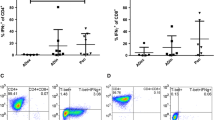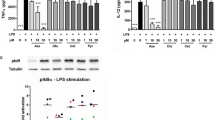Summary
Epidermal lymphocyte chemotactic factor (ELCF) from skin overlying a positive tuberculin reaction was compared with the chemoattractants leukotriene B4 (LTB4), N-formyl-methionyl-leukylphenylalanine (FMLP), and complement split product C5a (C5a). The chemotactic assay used is a modified Boyden chamber technique. The lymphocytes were subsets of T lymphocytes from healthy young individuals first separated by flotation of E rosettes on Isopaque Ficoll followed by incubation of T cells with anti-CD4 and anti-CD8 monoclonal antibodies and further separation using fluorescence-activated cell sorting. ELCF specifically attracted OKT4+ lymphocytes, while LTB4, FMLP, and C5a induced significant migration in both OKT4+ and OKT8+ lymphocytes without any clear difference between the various chemoattractants or cell populations. We found no blocking of the chemotactic capacity of ELCF when we added antibodies towards IL-1α and IL-1β to the chemotactic assay. Further recombinant IL-1α and IL-1β did not induce any chemotactic response. Our observations may be of significance in explaining the predominance of OKT4+ cells in allergic contact dermatitis and certain other skin diseases.
Similar content being viewed by others
References
Baker BS, Swain AF, Griffiths CEM, Leonard JN, Fry L, Valdimarsson H (1985) Epidermal T lymphocytes and dendritic cells in chronic plaque psoriasis: the effects of PUVA treatment. Clin Exp Immunol 61:526–534
Chu AC (1983) The use of monoclonal antibodies in the in situ identification of T-cell subpopulations in cutaneous T-cell lymphoma. J Cut Pathol 10:479–498
Gawkrodger DJ, McVittie E, Carr MM, Ross JA, Hunter JAA (1986) Phenotypic characterization of the early cellular responses in allergic and irritant contact dermatitis. Clin Exp Immunol 66:590–598
Larsen CG, Ternowitz T, Larsen CG, Thestrup-Pedersen K (1988) Epidermis and lymphocyte interactions during an allergic patch test reaction. Increased activity of ETAF/Il-1, epidermal derived lymphocyte chemotactic factor and mixed skin lymphocyte reactivity in persons with type IV allergy. J Invest Dermatol 90:230–233
Larsen CG, Ternowitz T, Larsen FG, Thestrup-Pedersen K (1988) Epidermis and lymphocyte interactions during a tuberculin skin reaction. I. Increased ETAF/Il-1 activity, expression of tissue antigens and increased mixed skin lymphocyte reactivity. Arch Dermatol Res (in press)
Miossec P, Yu C-L, Ziff M (1984) Lymphocyte chemotactic activity of human interleukin-1. J Immunol 133:2007–2011
Sauder DN, Monich MM, Hunninghake GW (1985) Epidermal-derived thymocyte-activating factor (ETAF) is a potent T-cell chemoattractant. J Invest Dermatol 85: 431–432
Schröder J-M, Christophers E (1987) Identification of C5a-des arg and an anionic neutrophil-activating peptide (ANAP) in psoriatic scales. J Invest Dermatol 87:53–58
Ternowitz T (1985) Human monocyte and neutrophil chemotaxis in vitro employing 51Cr-labelled leucocytes. Acta Pathol Microbiol Immunol Scand [C] 93:189–193
Ternowitz T, Thestrup-Pedersen K (1986) Epidermis and lymphocyte interactions during a tuberculin skin reaction. II. Epidermis contains specific lymphocyte chemotactic factors. J Invest Dermatol 87:613–616
Author information
Authors and Affiliations
Additional information
This work was supported by the Danish Medical Research Council grants no 12-6132 and 12-5691
Rights and permissions
About this article
Cite this article
Zachariae, C., Ternowitz, T., Larsen, C.G. et al. Epidermal lymphocyte chemotactic factor specifically attracts OKT4-positive lymphocytes. Arch Dermatol Res 280, 354–357 (1988). https://doi.org/10.1007/BF00426613
Received:
Issue Date:
DOI: https://doi.org/10.1007/BF00426613




